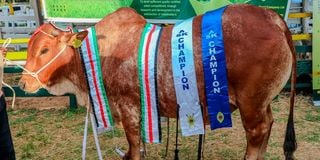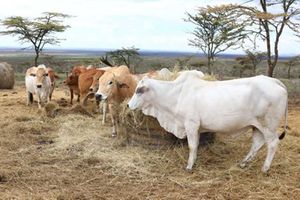
A champion bull at Jamhuri Park during the Nairobi International Trade Fair on September 26, 2024.
Most farmers believe they breed animals but what they do is to mate animals. A farmer is not even able to tell the father or sire of the offspring on many occasions. This often results in animals with poor traits due to inbreeding.
The practice of mating is simply ensuring that an animal that comes on heat is inseminated naturally by a male in the group to produce a young one. It has no consideration of the quality of animals to be born. This is bad because the quality of livestock deteriorates with time.
Mating generates animals with bad traits, including undue aggression, poor production, genetic deformities and low disease resistance.
Growing up, I used to see he-goats with small bodies, long horns and goatees. We thought they were types of goats but they were indeed products of inbreeding due to the extensive practice of mating.
Breeding is the controlled propagation of domestic animals so as to improve desirable qualities.
These qualities include high production performance, increased disease resistance, environmental tolerance, docility and task performance.
Humans have practised livestock breeding for centuries to better suit their needs. Most donkeys, for instance, are obedient in carrying loads for humans because those with aggressive and obstinate behaviour are removed from the population through breeding.
In communities that use bulls for ploughing, aggressive, lazy, difficult to train and stubborn bulls are not bred. Eventually, the trait is eliminated from the working cattle population.
Breeding may also be termed selective mating. It involves the use of knowledge from several branches of science.
They include genetics, statistics, reproductive physiology, computer and molecular science.
Genetics deals with the chemical building blocks in the cells that control the body’s growth and development to give the observed characteristics of an individual animal.
Therefore, an animal with desirable observable traits is also said to have good genetics.
The observable traits of an animal such as colour, size, behaviour and production are called phenotype.
The other characteristics that are not observable but can be determined by scientific analysis are genotype.
Genetics is the most critical aspect of breeding as it determines the type of animal one gets. While other factors like environment and nutrition can be controlled for the animal to express its genes through its phenotype, the genetic makeup is permanent and can only be altered through breeding.
I recall a farmer who bought small East African Zebu calves for beef rearing. The calves were a nice brown and looked healthy and energetic.
As the animals grew, the farmer noticed they kept changing, becoming compact and small for their age.
The legs also appeared to get longer relative to the body and meat was only packing high up in the base of the limbs.
When the farmer consulted me on the development of her cattle, I explained that the calves were expressing their normal phenotype. They were not bred for the table she could not make them pack more meat than their genotype.
Kenyan livestock farming, especially for beef, pigs, sheep and goats is small-scale. Farmers lack easy access to breeding knowledge and expertise due to their environment, low level of education and low economic status.
It is, however, possible for farmers to improve their animals through good breeding practices.
If farmers understand the basic principles of how populations of animals can be changed by utilising the observable traits and historical data, they can learn how to improve and maintain quality livestock without access to complex scientific services of molecular genetics and newer reproductive technology.
Interestingly, most serious pastoral farmers have indigenous breeding knowledge accumulated over time.
Three weeks ago, I visited farmers in a remote region of Kajiado County. I was impressed by the size and appearance of some cattle, sheep and goats in a number of bomas.
The farmers talked little Kiswahili but were fully conversant with good breeding practices.
Their goats were of the Gala type, sheep were Dorper and the cattle were Boran, Sahiwal and their crosses or mixes.
The farmers explained that they usually select their animals for breeding by how easily they are expelled from the uterus (ease of birth), how well they feed, how fast they grow and their breed colours.
They also look at the body form to ensure there are no deformities and the animals’ final body weight.
I was impressed by the farmers’ knowledge of breeding principles despite their low level of education.
I encouraged them to improve their knowledge by interacting with other more knowledgeable farmers and animal health service providers.
In addition to those traits the farmers usually check, I advised them to add the size and symmetry of the testicles in breeding males. Testicles should be double, of the same size, large and hanging down from the body attachment.
I noted some males that had only one testicle and others where the scrotum was too close to the body attachment point. Such animals should not be used for breeding.
For female animals, I advised the farmers to always check the size, symmetry and spacing of the teats.
Animals with multiple teats or teats without an opening should not be used for breeding.
It is good to note that on rare occasions, animals may inbreed and produce offspring with desirable traits such as large body size or lack of horns.
Such animals could also be used for breeding if the benefit of the desirable traits is higher than the cost of inbreeding traits.







